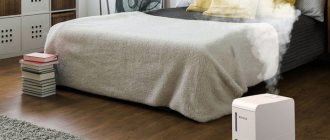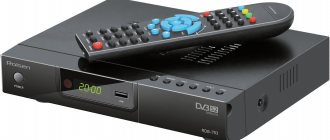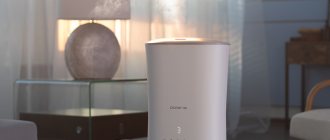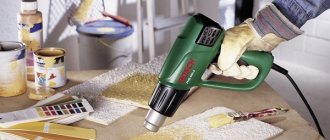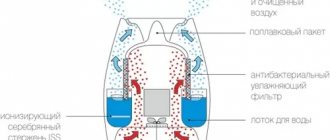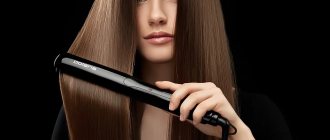Indoor air quality affects human health. Lack of regular cleaning and ventilation contributes to the accumulation of pathogenic microorganisms and allergens, which cause frequent illnesses.
Ionizers are designed to improve the air quality in your apartment and house. These devices appeared on the market relatively recently, but today they are experiencing a surge in development and interest in them from buyers. What is an air ionizer? How does he work? Is it useful, or is it all an invention of marketers? And how to choose a device for home use? Read about it in the FAN .
Why do you need an air ionizer?
An ionizer is a device that saturates the air with positively and negatively charged particles of oxygen and nitrogen. In nature, this process occurs naturally. Its “initiators” are ultraviolet radiation and lightning discharges, under the influence of which molecules of air gases “split” and lose or gain electrons. Such incompletely “charged” molecules are called ions.
If you compare the air in an ordinary city apartment with that in the countryside, it turns out that the concentration of ions in it is 15-20 times lower. At the same time, at the beginning of the last century, scientists, including Soviet ones, put forward the theory that air saturated with negative ions is especially beneficial for health. Research in this direction was carried out by Soviet biophysicist Alexander Chizhevsky , who proposed artificially saturating indoor air with negative ions.
For this, he developed a device, later named the Chizhevsky lamp in his honor. Externally, the device actually resembled a lamp: an oblong sphere, enclosed in a metal casing, suspended from the ceiling and connected to the mains. Under the influence of the device, the concentration of air ions in the air increased - this is what Professor Chizhevsky proposed to call charged air particles.
According to Chizhevsky, air saturated with such particles has a therapeutic effect:
• reduces the tendency to catch colds; • reduces the severity of allergic reactions and chronic respiratory diseases; • promotes normalization of rest; • increases performance.
Elimination of aeroion deficiency in rooms, as Chizhevsky believed, is beneficial for the functioning of the heart, blood vessels, and brain.
Fact. Soviet science did not fully recognize the research of Alexander Chizhevsky. His work has been repeatedly criticized, including for violation of experimental methods. Until now, the theory about the therapeutic effects of ionized air on the body has not been officially confirmed. But the ability of the ionizer to cleanse the air of pollutants has been proven.
Federal News Agency /
Harm from ionization
The main disadvantage of ionization is that various pathogenic bacteria and microorganisms quickly spread in the air leaving the device, which increases the risk of contracting viral diseases. Ozone released in high concentrations destroys healthy cells in the body. The ionizer is especially harmful for cancer patients, since air ions accelerate metabolic processes, improve cell nutrition and blood circulation. Malignant tumors that receive more nutrition accelerate their growth. It is strictly forbidden to use the device in the presence of inflammatory processes in the body and for a month after surgery. Heavy air ions make breathing difficult, preventing the lungs and respiratory tract from being freed from dust. Frequent and prolonged use of the ionizer contributes to the accumulation of static electricity in the premises. It is recommended to regularly carry out wet cleaning around the ionizer to remove dust that has settled under the influence of negative ions. You should not use the ionizer if you have health problems:
- diseases of the upper respiratory tract, nervous system, joints;
- exacerbation of bronchial asthma;
- cancer patients;
- hypertension, vascular sclerosis of the brain and heart;
- at high temperature and inflammatory diseases;
- high sensitivity to ozone.
If you experience headaches, irritability, or deterioration in health, you should also avoid air ionization.
How does an air ionizer work?
Modern ionizers are hardly similar to the devices proposed almost a century ago by a Russian professor. However, the principle of their operation has not changed. They generate a current that splits air gases - oxygen and nitrogen. Thanks to their influence, the content of ions (negative or positive) in the air increases several times.
There are two types of devices on the market: • bipolar; • ordinary.
The former generate particles with both positive and negative charges. Conventional ones produce only negative particles, “adding” an extra electron to the oxygen and nitrogen molecules. Most devices intended for domestic use operate on this principle.
Fact. Every second the ionizer produces millions of charged particles. The more powerful the device, the faster it saturates the air in the room. Therefore, the operating time of high-power devices must be strictly limited, while low-power or intensity-controlled devices can operate longer, for example, throughout the night.
Features of the device and principle of operation
The question of what an air ionizer is arises quite rightly. After all, the benefits of negatively charged ions are practically not mentioned in traditional medicine.
However, the operation of the device has a positive effect on the body as a whole.
So, the operating principle of an air ionizer is as follows:
- the device sucks in air, dust and odor;
- Once small particles enter the device, they are exposed to a high voltage electric field;
- this field charges small particles positively;
- positively charged particles pass through a negatively charged filter;
- the negative charge ionizes the oxygen molecules that remain in the amount of intake flow;
- negatively charged oxygen molecules re-enter the room, filling the air with freshness.
This is where the operating principle of the device itself ends. There may be some discrepancies and deviations from the norm depending on the device and the components used.
The benefits of an air ionizer
Molecules with an extra electron become charged and become invisible, microscopic “magnets.” They capture and attract microparticles of pollutants present in the air. Large particles of dust, suspended debris, allergens, even bacteria “stick” to them. The only thing they cannot cope with is viruses, as they are too small. Therefore, trying to clean a room from viral infection using an ionizer is a pointless undertaking.
But since, in general, the air quality in the house and apartment becomes better, the ionizer can be useful for people who suffer from allergic reactions and frequent diseases of the respiratory system. It is advisable to install it in a bedroom, children's room, or office. In winter, when proper ventilation is not possible, the device will help keep your living space clean and safe.
pixabay.com/PD/
Air ionization - what is it and why is it needed?
We breathe dirty air, saturated with dust, germs, exhaust gases and toxic compounds, we are surrounded by artificial upholstery, artificial building materials - all these harmful substances settle on the lungs and contribute to the development of many diseases. Needless to say, how detrimental electromagnetic and radio waves emitted by electronics affect humans?
Air ionizers
Air ionizers are designed to save the situation and improve the microclimate. By saturating the air with beneficial anions, they significantly improve air quality, which has a positive effect on overall well-being.
People who use this household appliance experience a surge of strength. Their headaches and dizziness go away, mental and physical performance increases, and sleep normalizes.
Who needs an air ionizer most:
- For older people and people suffering from chronic diseases: metabolic disorders, chronic fatigue syndrome, chronic bronchitis and bronchial asthma, diseases of the cardiovascular system.
- The ionizer is useful to use as a prophylactic agent during an epidemic of viral diseases. Air disinfection occurs due to the production of ozone by the device. Powerful medical air ozonizers are used in medical institutions to disinfect premises. However, in high concentrations, ozone is a poison, so you cannot stay in the room while the ozonator is operating. The procedure for turning on and using the ozonizer is strictly regulated by the relevant rules. However, ozonizers are rarely used in everyday life.
- People working at a computer and in enclosed spaces.
Sleeping in a room with an ionizer is pleasant and beneficial
Harm of air ionizers
It is important to understand that particles of contaminants do not disappear from the room. They only “stick” to the air ions, and then to the nearest surface. Therefore, after using the air ionizer in the room, it is necessary to carry out wet cleaning. Otherwise, all the dirt will remain in it: on the floor, walls, countertops and window sills.
It is also worth considering other features of the device.
• The device should not operate around the clock. This makes no sense, since it does not have a disinfecting effect. The operating time of the device must be limited. For a powerful effect, 15 minutes a day is enough, for example, before going to bed or starting a working day. After this, turn off the device and wipe the surfaces with a clean, damp cloth. • You should not be near the ionizer. The safe distance for a person is at least a meter. Manufacturers often recommend leaving the room while the device is operating. Therefore, the most appropriate technique for using it would be to leave the room, close the door and let the device purify the air. • There is a risk of static electricity building up. The less power a device has, the safer it is considered. In this case, the risk of excessive accumulation of negative charges in space tends to zero. However, you shouldn’t keep even a low-power device plugged in 24 hours a day. It has been proven that static electricity accumulates in rooms in which the ionizer operates for a long time. It does not cause any harm to humans, but it can have a negative effect on equipment. • Ozone odor is dangerous. Air saturated with ozone is considered healing, but this is a common misconception. In fact, this gas is extremely toxic, and since ozone is a “modified version” of oxygen, it can appear during the operation of the ionizer.
Advice. When choosing an ionizer, pay attention to its characteristics. The passport must indicate the volume of ozone produced by the device. A safe indicator is no more than 0.1 mg per cubic meter of air. If this parameter is not indicated in the device passport, refuse to purchase. If you notice a strong, characteristic smell of ozone during operation of the device, turn off the device and ventilate the room, and in the future reduce its operating time.
The use of an air ionizer does not eliminate the need for regular ventilation of the room. Only in combination with it and daily wet cleaning will the device help maintain a safe microclimate in the house and apartment.
pixabay.com/Free-Photos
Disadvantages of using the device
Such devices also have disadvantages that those who care about their health should be aware of:
- The charge is transferred not only to the air, but also to other particles, including dust and bacteria. Because of this, the attraction of dust to different surfaces increases. Dust deposits appear on furniture more often than before purchasing the ionizer, which means wet cleaning needs to be done every few days. Otherwise, all these dust masses will rise into the air you breathe. When charged dust enters the lungs, it can not only cause sneezing and coughing, but can also cause serious illness. In some countries of the world where there is no free access to water, the sale of ionizers is prohibited. If you have the opportunity to regularly clean the entire area of the room, then the ionizer will be safe.
- The appearance of ozone in the air. Often the ionization process contributes to the formation of ozone in the air. If there is a fresh aroma in the room, like after a thunderstorm, then this indicates the presence of ozone. The room needs to be ventilated. The pleasant smell is deceptive, since the substance is a strong oxidizing agent.
There are also contraindications to the use of ionizers. For a number of diseases, the use of such devices is not recommended. Among them:
- oncological diseases,
- bronchial asthma in the acute stage,
- cold with fever,
- cerebral circulatory disorders.
Rating of the best air ionizers for apartments and houses
When choosing a device, give preference to one that produces negatively charged particles in a volume of up to 50 thousand per cubic centimeter of air. This is the recommended standard for residential premises.
Please also note the following device specifications.
1. Area of processing of the room. The manufacturer indicates the recommended area that the device can clean. Choose a device that fits the area of the room where you plan to use it. 2. Filter system. The efficiency of air purification depends on its quality, so it is preferable that the filter system contains several elements, for example, an ESP filter and a photocatalysis filter. 3. Dimensions. Manufacturers offer models for floor and tabletop installation. The first ones are larger, designed for processing large areas. If you intend to use the device in one room, it is enough to choose a compact desktop device designed to clean a room of 10-25 sq.m. Floor-standing models can handle up to 110 “squares” of space.
Fact. Compact devices can operate both from the network and USB. And if you want the air in the room to become not only clean, but also filled with pleasant odors, give preference to an ionizer with an aromatization function.
BiOSE Ion-Effect
Pr Scr Yandex.Market /
The compact device can be placed on a table or mounted on a wall, making it an excellent solution for families with small children. A small device in a neat white case is equipped with a power button and an indicator light. The air passes through the grilles on the front and side surfaces of the ionizer and is saturated with negative particles with a volume of 50 thousand air ions per cm3. Its power is enough to treat a room up to 25 m2.
According to reviews, the device consumes almost no electricity, the smell of ozone is not felt during operation, so users are not afraid to leave it on all night. The front panel display is convenient in a child's room - no additional night light is needed. The device copes with its task: users note that the air becomes cleaner and fresher. However, some consider it too weak, and the area indicated by the manufacturer is overestimated.
The average price is 1300 rubles.
Boneco P50
Pr Scr Yandex.Market /
The device weighs only 300 grams and is so compact that it is convenient to use not only at home, but also to take it with you to work or turn it on in the car. It works from the network and a USB port, and can be plugged into the cigarette lighter inside the car. The device is designed for a small area - only 10 square meters, but it is quite enough to purify the air in a study, in a small bedroom or in a car. The gadget can not only saturate the air with charged particles, but also aromatize it: the aromatic capsule can be filled with oils with your favorite scents.
According to users, the device is convenient due to its compactness. The air in the immediate vicinity of it actually becomes pleasant and feels fresh. But the filter that comes with the device raises questions and seems ineffective.
The average price is 3990 rubles.
Principle of operation
The device produces anions according to the Chizhevsky chandelier circuit. Inside it there are negative and positive ionizing electrodes, to which high voltage is applied. Getting a negative ion occurs like this:
- Under the influence of current, a corona discharge is formed between the electrodes, as a result of which air ions are released into the air.
- These air ions mix with oxygen molecules contained in the room - due to this, the room is filled with anions. The particles settle on the dust, causing it to sink.
The impact of the device remains within a radius of 2–3 meters.
Operating principle of the ionizer
Yantar-5A
Pr Scr Yandex.Market /
The model differs from its analogues in design. It is enclosed in a wooden case and equipped with a decorative grille, behind which the electronic “stuffing” is not very well disguised. The device does not look very modern, but it will be a good alternative for users who want to get away from the abundance of plastic in the interior. It copes well with ionization functions: it cleans a room of up to 25 square meters, makes almost no noise, operates on mains power and is equipped with three modes. Selecting a mode allows you to set the number of particles produced by the device.
According to users, the device looks nice and is equipped with a remote control, making it convenient to use. The range of adjustments is wide, there is no smell of ozone during operation, you can breathe easier in its “presence” and sleep better. Among the disadvantages, they note the impossibility of switching the device to unipolar mode: the manufacturer only provided bipolar, which confuses some users.
The average price is 4800 rubles.
AIC XJ-2100
Pr Scr Yandex.Market /
This device is considered universal, since three useful functions are contained in a compact case. The device not only ionizes the air, but also treats it with ultraviolet light, thereby destroying viruses and bacteria, and complements disinfection with ozonation. The latter function requires the device to operate only at times when there are no people in the room. At the same time, processing an area of up to 25 sq.m. takes less time compared to other devices: the AIC XJ-2100 design includes a fan that accelerates air movement.
Users believe that the device copes with its tasks: it cleans and disinfects the air, refreshes it, and does it almost silently. There is no need to change the included filter; just remove it and rinse it under running water. The design of the device is modern, the cost is adequate. Disadvantages are discovered at the moment of breakdown: purchasing a replacement UV lamp after the “standard” one fails is not an easy task.
The average price is 4899 rubles.
Terms of use
To get the most positive effect from using an ionizer, you need to use it correctly. If you violate the instructions, you can cause harm to yourself and other people instead of benefit.
Before turning on the ionizer, ventilate the room well. After this, activate the device and leave the room for 20 minutes. During this time, the ionizer will first clear the air of germs, dust, allergens and bacteria. This will happen due to the fact that it will electrify all the microparticles, and they will settle on the surface. After this, oxygen ionization will occur in ideally clean air.
After 20 minutes you can enter the room. The first step is to carry out wet cleaning to remove all settled particles. The ionizer can be left on, but keep your distance. It is undesirable to approach a working device closer than a meter (meaning, stay in close proximity for a long time). Smoking should not be allowed in the room where the household ionizer operates, otherwise smoke and all substances will settle in the respiratory tract and lungs.
To protect the ionizer from the effects of a monitor, household appliances or printer, you need to place it near a specific device. So you can place it 0.5 m from the monitor on the wall.
As for caring for the ionizer, there is nothing complicated about it. The only thing required is cleaning the filter. Its frequency and method of implementation depend on the type of filter. If it is electrostatic, then it needs to be washed under running water once every 10 days. For devices that humidify the air, the filter is washed every week. The Nero filter is not washed, but vacuumed once a month, but it must be replaced annually.
The effect of air on the body
The human body only absorbs ionized air, and in most people’s homes there are very small amounts of negative ions. According to SanPiN standards, the airspace must contain from 400 positive ions per cubic centimeter and 600 negative ions. Which leads to the conclusion: home air is harmful. Due to the small amount, performance decreases, the following appears:
- fast fatiguability;
- low performance;
- poor concentration;
- headache;
- migraine;
- frequent colds;
- premature aging.
Air filled with light ions is present in nature, far from cities. You can get your fill of it by the sea, in the forest, in the mountains and after a thunderstorm. But not everyone manages to visit such places often. That's why the ionizer was invented.
They spoil the air, saturated by nature with ions:
- traffic fumes;
- factories;
- electrical devices;
- poor ventilation.
Operating rules
To protect yourself and get the maximum benefit, first of all, when purchasing, study all the characteristics and check for quality certificates.
It is mandatory to read the instructions and follow them:
- Can only be used at a distance of at least 1-3 meters from a person.
- Exclusively short-term use. Depends on the model, on average about 15 minutes.
- Ventilate the room regularly.
- It is enough to turn on 2-3 times a day.
- Area less than 20 square meters. m. a weak device is suitable, and for a larger area - a powerful one.
- If a filter is present, it must be changed once a year and washed every week.
- Smoking while the air ionizer is on is prohibited.
It must be remembered that some models may emit more ozone. It belongs to the first class of dangers. May lead to poisoning: vomiting, headache, asthma, bronchitis. If a strong, pronounced odor appears, you must immediately turn off the device and open the windows.
Rules for operating the ionizer
